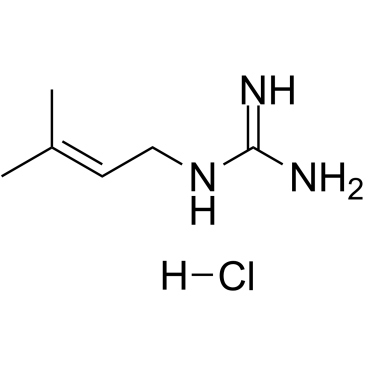2368870-39-5
| Name | Galegine hydrochloride |
|---|---|
| Synonyms | MFCD32069582 |
| Description | Galegine hydrochloride, a guanidine derivative, contributes to weight loss in mice. Guanidine hydrochloride is the compound derived from G. officinalis, which gave rise to the biguanides, metformin and phenformin. Galegine hydrochloride activates AMPK in 3T3-L1 adipocytes and L6 myotubes, as well as in the H4IIE rat hepatoma and HEK293 human kidney cell lines. Galegine hydrochloride has antibacterial activity, with minimum inhibitory concentration of 4 mg/L against Staphylococcus aureus strains[1][2]. |
|---|---|
| Related Catalog | |
| In Vitro | Pre-treatment with Galegine hydrochloride (10 μM-3 mM; 5 h) produces a concentration-dependent stimulation of insulin-independent glucose uptake by 3T3-L1 adipocytes without any effect on cell viability. Incubation with Galegine hydrochloride (1 μM-1 mM, 5 h) produces a concentration-dependent stimulation of glucose uptake into L6 myotubes, again without any effect on cell viability[1]. Galegine hydrochloride (0.3-300 μM; 24 hours) produced a slight reduction in basal glycerol release and a more marked reduction in isoprenaline-stimulated glycerol release from 3T3-L1 adipocytes. Incubation of H4IIE rat hepatoma cells with Galegine hydrochloride (10 or 300 μM) for up to 6 hours produces a time-dependent activation of AMPK measured in cell lysates, with maximal activation at 360 min and twofold activation still evident at 24 hous in the presence of 300 μM Galegine hydrochloride. The effect of 300 ΜM Galegine hydrochloride is markedly greater than that of 10 μM. Incubation with Galegine hydrochloride for 1 hour produces a concentration-dependent activation of AMPK in both 3T3L-1 adipocytes and L-6 myotubes. Galegine hydrochloride also produces a concentration-dependent activation of the enzyme in a human kidney cell line (HEK293)[1]. |
| In Vivo | Galegine hydrochloride (63 mg/kg; feed; daily for 11 days) produces a significant reduction in body weight[1]. Animal Model: Adult male BALB/c mice[1] Dosage: 63 mg/kg Administration: feed; daily for 11 days Result: Produced a significant reduction in body weight. |
| References |
| Molecular Formula | C6H14ClN3 |
|---|---|
| Molecular Weight | 163.65 |
| Storage condition | 2-8°C |
